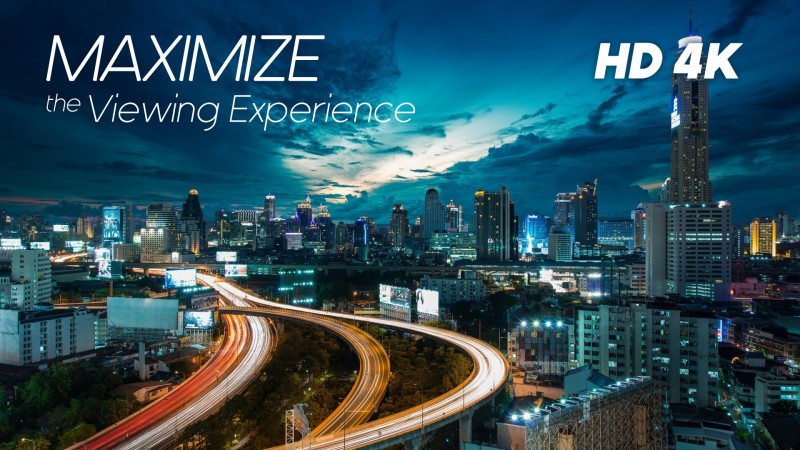TV and Monitors HD 4k: Viewing Distance
In the previous episode we discovered how works resolution on HD and 4K TV and monitors, we also discovered how to calculate and how it affects on the vision quality; we have also seen what is the human eye resolution and how to calculate it. But to get the most out of our high resolution TV and Monitor, we have to know more and be able to calculate the correct viewing distance.
Calculate the Viewing Distance
The fundamental theorems on the resolution can be summarized in this way:
The higher the resolution, the lower may be the distance from the screen. The greater the distance, the smaller can be the resolution.
This simple theorem allows us to choose the best TV or the best monitor based on the viewing distance we want to achieve, or to calculate the correct viewing distance to take full advantage of all the details that our panel is able to show.
The Viewing Distance calculator for HD & 4K TV and Monitor, indicates the minimum, maximum and recommended distance to have in relation to the diagonal of the display and desired resolution. The recommended distance is based on 10/10[1] visual acuity[2].
Greater the visual acuity, the higher is the ability to perceive details at longer distances. When it’s lesser, the viewing distance decreases; that means you need to get closer to the screen to fully enjoy the benefits of high resolution devices.
Unfortunately, not everything that glitters is gold. Stray too far, causes a gradual and inevitable decline of details that implies a total o partial decrease of HD, 4K TV and Monitors benefits. On the other hand, approaching too much to the source can cause eye strain.
According to research conducted by SMPTE, watching an Ultra HD television too close, can cause side effects in some people similar to who’s suffering from kinetosis[3][4], in particular on people with a lower visual acuity.
Full HD and 4K Differences
In the example below, you can see the same image at different resolutions. When the distance from the source is too high, the two images in Full HD and 4K look exactly identical.

The 4K resolution (UHD) is recommended for close viewing distances, or TV panels much larger than average[5]. Beyond 6 feet you must have at least a 70-inch panel to observe noticeable differences between Full HD and 4K, although a 90/100-inch display it’s preferable. If you want to buy a 40/50-inch TV, the best deal is to sit at a distance between 3.5 and 5 feet. There’s also to add that with a properly calibrated system, details perceptible in 4k are exceptional and enable unprecedented image fidelity, although perhaps not as obvious as happened with the transition from SD contents to HD contents.
For movie fans, another factor to take into consideration at the moment, is the shortage of films and TV series in 4K native, both Blu-ray and online streaming, even if it’s provided that a lot of new content will arrive from December 2015. When we watch TV with a greater resolution than the input source, starts a process of resolution adaptation called upscaling[6]. This type of process always leads to visual artifacts and a relative loss of quality[7], with more or less optimal results depending on the quality of algorithm and processor used. In particular you might notice a grainy image.
Even for gamers, 4k resolution is a difficult goal. Impossible to achieve with any current console and quite expensive for a PC Gamer (at least for the next 1/2 years). For players who want to leave behind the Full HD resolution without breaking the bank, a Quad HD monitor (1440p) could be a balanced solution and allows us to obtain a clear qualitative leap.
Notes:
- According to the Snellen chart it corresponds to 20/20. If you do not know your visual acuity, you can use an online visual acuity test. ⬆
- Visual acuity is one of the main visual skills of our visual system and is defined as the eye’s ability to perceive and resolve details of an object depending on how sharpen appears an image on the retina. – Wikipedia ⬆
- Kinetosis or motion sickness is characterized by nausea, vomiting, dizziness, pallor and sweating – Britannica ⬆
- Research on Human Factors in Ultrahigh-Definition Television (UHDTV) – SMPTE ⬆
- For 55/65-inch TVs, Sony recommends a range between 5 and 6 ft as ideal distance for 4k Ultra HD resolution. Even THX recommends to sit at similar distances. ⬆
- Upscaled 1080p vs Native 4K. – Red ⬆
- Unlike the reverse process, downscaling, ie forcing a source at higher resolution in a lesser resolution panel, that in some cases may improve the image quality. – Why Does 4K Look Better on 1080p Monitors. ⬆
